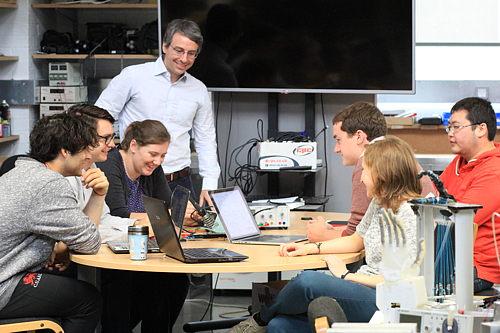
Submitted by Administrator on Thu, 16/06/2016 - 17:36
A research paper on assisted living technology, authored by the first cohort of Sensor CDT students, has been published in the Royal Society's Interface Focus journal.
The first cohort at the Sensor CDT has just published the results from the Sensor Team Challenge - a 12-week project carried out during the MRes year. The research article, “Development of an open technology sensor suite for assisted living: a student-led research project”, features in the theme issue “Sensors in technology and nature” in the Royal Society’s Interface Focus journal.
With rapidly ageing populations placing increasing pressure on health services in the UK and many other countries, there is increasing demand for assisted living technologies to enable older people to live independently and safely in their own homes for longer.
But as team member Oliver Bonner, an electronics engineer, explains: “Existing monitoring devices are often too bulky, only perform one function and can’t be integrated because manufacturers don’t want their products used alongside those of rival brands. What we’ve done is develop an open platform so that anyone who invents an ingenious assistive device can bring that into the system and enhance what it can do for older people.”
The interdisciplinary team – comprising engineers, chemists, biochemists, materials scientists and physicists – designed and incorporated five assistive devices into their sensor suite: a door sensor, power monitor, fall detector, general in-house sensor unit, and an on-person location-aware communications device. The group improved on existing devices, in part, by taking advantage of recent developments in 3D printing, printed circuit board production and electronics prototyping.
Josephine Hughes, who studied engineering as an undergraduate at Cambridge and is now pursuing a PhD in robotics, said: “We’ve created a non-intrusive safety net that can be used to help older people live independently in their own homes for as long as possible while also connecting them with their friends and family. We had to ensure that older people would accept the system.”
To protect the privacy of older people, the in-house system uses motion and audio detectors to establish presence but no cameras or sound recording devices. Towards the end of the project, the team installed their sensor suite in the home of team member, Philip Mair, a biochemist. With kind permission from Mair’s flatmates, the group tested the system for two weeks and, to their relief, discovered that it was fully operational.
Extensive further testing would be required before the system could be commercialised but it has already generated expressions of interest from potential investors and manufacturers.
Reference:
Manton et al. "Development of an open technology sensor suite for assisted living: a student-led research project." Interface Focus 2016 6 20160018; DOI: 10. 1098/rsfs.2016.0018


